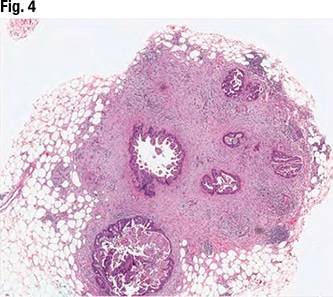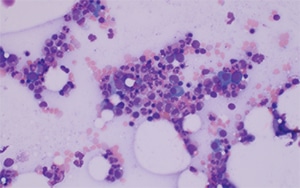July 2020—Gestational diabetes mellitus, if left untreated, is notoriously dangerous for mothers and their babies, making timely diagnosis critical. Yet the disease is similarly well known for being chronically under-diagnosed by laboratory testing.
Read More »July 2020
New checklist hones lab’s verification and validation requirements
July 2020—If a manufacturer assists a laboratory in setting up a new FDA-approved or -cleared test, the lab must make sure that the personnel who will perform the test participate in the verification or validation study.
Read More »Outbreak detection of novel pathogens: Is AI the answer?
July 2020—A machine learning algorithm, used in conjunction with BioFire’s Syndromic Trends, demonstrated a mechanism for near real-time outbreak detection of enterovirus D68, says a study reported in the Journal of Clinical Virology.
Read More »In CRC, distinguishing tumor deposit from lymph node
July 2020—When patients who have colorectal cancer surgery at another institution seek further care at Beth Israel Deaconess Medical Center in Boston, the Beth Israel pathologists routinely request the original slides. Raul S. Gonzalez, MD, a gastrointestinal pathologist at Beth Israel, says he usually agrees with everything the outside pathologist reports. But if there are differences, lymph nodes versus tumor deposits is one place where he might disagree.
Read More »Closing the workflow loop: HistoQC for digital slides
July 2020—Unveiled in 2018, HistoQC, an open-source quality control tool for digital pathology slides, was an “awakening to a problem” and the kickoff of a conversation, says Andrew Janowczyk, PhD, its main investigator. And while it’s hard to measure the tool’s use because it’s freely available, he says, reception has been strong. “It’s been a pretty good ride,” he says of its first two years.
Read More »AMP case report: Unexpected diagnosis of indolent systemic mastocytosis through evaluation of NGS data
July 2020—A 77-year-old woman presented at our institution for care with a remote history of lymphoma. Three years earlier she had a bone marrow biopsy performed that by report showed five percent monoclonal kappa restricted plasma cells. At the initial presentation at our institution, serum protein electrophoresis and immunofixation showed an IgA kappa paraprotein (0.52 g/dL), and bone marrow biopsy showed less than five percent plasma cells by CD138 immunohistochemistry that were kappa light chain restricted by flow cytometry, with normal renal function and calcium level. A PET-CT indicated no lytic bone lesions. These findings confirmed the diagnosis of IgA kappa monoclonal gammopathy of undetermined significance (MGUS). Her past medical history was remarkable for chronic oral ulcers for five years of possible autoimmune etiology that were responsive to methylprednisolone, a stroke, hypertension, and hyperlipidemia.
Read More »At UW, anatomic pathology rotation moves online
July—When COVID-19 set in, much of residency education in the U.S. moved online. At the University of Washington School of Medicine, anatomic pathology faculty took online learning a step further by creating a virtual two-week anatomic pathology rotation for medical students. The faculty is aiming for a four-week virtual rotation inclusive of more laboratory medicine, to be used even after the pandemic has passed.
Read More »A panel’s take on instruments, connectivity, COVID
July 2020—Has the pandemic changed your thinking or that of your customers? That’s one of the questions CAP TODAY publisher Bob McGonnagle put to seven representatives of five companies and two other panelists in a May 13 roundtable on chemistry/immunoassay analyzers and testing. But first up were other topics: scalability, connectivity, standardizing platforms across health systems, consistent sourcing of antibodies, and open automation.
From the President’s Desk: Remembering Gene Herbek
July 2020—It is with profound sadness that I write about the passing of a dear friend. Gene Herbek, MD, served as president of the CAP from 2013 to 2015, and many CAP TODAY readers will remember his informative column in these pages. For details about his life and accomplishments, please read his obituary in this issue (page 12). I’d like to spend this column focused on how he shaped the CAP, and what an honor it was to have known him.
Read More »In memoriam: Gene N. Herbek, MD 1949 –2020
July 2020— Gene N. Herbek, MD, CAP president from 2013 to 2015, died June 4 after a brief illness. He was a CAP governor from 1998 to 2004 and secretary-treasurer from 2006 to 2011. Dr. Herbek was medical director of the Methodist Women’s Hospital laboratory and medical director of transfusion services for The Pathology Center at Methodist Hospital, Omaha, Neb. He chaired multiple CAP groups over the years, among them the councils on Public Affairs and Membership and Public Affairs and the Finance, Credentials, Nominating, Political Action, and Insurance committees.
Read More »Clinical pathology selected abstracts
July 2020—The College of American Pathologists launched the Pathology and Laboratory Quality Center for Evidence-Based Guidelines in 2009 to develop and promote laboratory practice guidelines (LPGs) using the National Academy of Medicine’s (NAM) standards for developing trustworthy guidelines. The center has published 17 evidence-based LPGs, including updated versions, using NAM’s criteria. In 2013, the CAP was awarded a five-year cooperative agreement grant from the Centers for Disease Control and Prevention to increase the effectiveness of its LPGs. The intent of the agreement was to assess awareness and adoption of two CAP LPGs: IHC assay validation (IHC VAL) and initial workup of acute leukemia (AL).
Read More »Anatomic pathology selected abstracts
July 2020—Smooth muscle tumors represent the second most common mural mesenchymal neaoplasm in the gastrointestinal tract, yet established criteria for prognostically assessing these tumors are lacking. The authors conducted a study on a large cohort of surgically resected intramural gastrointestinal smooth muscle tumors from 31 institutions to identify potential prognostic features. At each location, expert gastrointestinal or soft tissue pathologists, or both, assessed pathologic features. IHC confirmation was required.
Read More »Molecular pathology selected abstracts
July 2020—Drug-induced hypersensitivity syndrome/drug reaction with eosinophilia and systemic symptoms (DiHS/DRESS) is a rare but well-known full-body inflammatory skin condition that leads to life-threatening complications if untreated. The authors conducted a case study that involved a 44-year-old male who developed DiHS/DRESS after taking the combined antibiotic trimethoprim-sulfamethoxazole. Following standard treatment for this condition, the patient was started on high-dose prednisone, which provided no benefit. Subsequent tapering of prednisone advanced the disease to a toxic epidermal necrolysis-like condition. The patient was then given etanercept and high-dose intravenous immunoglobulin, without benefit. Next, the patient received cyclosporine, which resulted in some improvement but led to uncontrollable renal hypertension.
Read More »Q&A column
Q. Is it acceptable for a clinical laboratory to calculate ionized (free) calcium if calcium ion-selective electrode is not available? Are results of calculated ionized (free) calcium of acceptable accuracy in clinical practice? And what is the recommended formula for performing this calculation? Read answer. Q. Under checklist requirement COM.04250 “Comparability of Instruments and Methods —Nonwaived Testing,” what is the minimum number of samples that should be analyzed and which acceptance criteria should be used for the comparison? In addition, what parameters in the complete blood count do not apply for comparison purposes? Read answer. Q. I read an article about phlebotomy that stated for proper patient care, the recommended maximum number of blood draw attempts is four. The hospital at which I work recently implemented a procedure in which the nurses perform blood draws, instead of laboratory personnel. The procedure requires a nurse to attempt a blood draw twice and, if not successful, ask another nurse, and then ask the nursing supervisor before finally calling the laboratory. This policy has been difficult for hospital staff, and I feel terrible for patients who get stuck numerous times. Can you provide feedback that I can use to express my concerns to hospital administration? Read answer.
Read More »Newsbytes
July—In the early days of the COVID-19 pandemic, when the University of California, Berkeley's Innovative Genomics Institute decided to rapidly shift gears from conducting research to testing the community for SARS-CoV-2, some insiders may have thought the university was biting off more than it could chew under a tight timeframe. Yet a look at the lab 23 days later surely had any doubters eating their words.
Read More »Put It on the Board
AMP recommends PGx alleles for genotyping testing for warfarin response July 2020—The Association for Molecular Pathology published in May consensus, evidence-based recommendations to aid in the design, validation, and interpretation of clinical genotyping tests for the prediction of warfarin response. The new guideline on clinical warfarin sensitivity genotyping allele selection completes a series of three reports intended to facilitate testing ...
Read More » CAP TODAY Pathology/Laboratory Medicine/Laboratory Management
CAP TODAY Pathology/Laboratory Medicine/Laboratory Management









